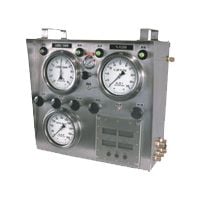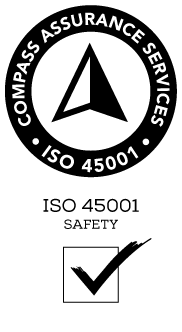PMMS-1000 Pneumatic Mud Monitoring System
Item Code: 8611
State-of-the-art system provides precision mud deviation measurement.
The PMMS-1000 Pneumatic Mud Monitoring System indicates mud deviations with an accuracy of ± 1 BBL. Clearly readable 6-inch gauges quickly indicate sudden mud changes caused by gas intrusion or formation breakdown. The system consists of Gauges, Console, Flow Sensor, Stroke Counter, and Pit Probes. Gauges can be mounted with other gauges in a stainless steel console or used as individual, freestanding units.
– – – – –
To order specify:
- Total mud volume in BBLs
- Number of pits
- Depth of pits
- Whether or not a trip tank is needed
- Trip tank volume and depth
Features
Standard indicators include:
- PMMS Console
- Loss/Gain Indicator with high/low alarms
- Total BBLs Indicator
- Percent of Return Mud Flow Indicator with high/low alarms
- Pump Stroke Counter and Pump Rate Indicator
- Pit Room Total BBLs Indicator
- Stainless steel vertical pit level sensor probes to a depth of
25 feet. - Approved for hazardous locations.
- Gauges can indicate measurements for a single pit or total measurements for multiple pits.
- Pump Stroke Counter and Pump Rate Indicator feature a digital display in a stainless steel case and a safe lithium battery — eliminating the need for a hazardous 110 VAC.
- Mountable in a drilling console or in a freestanding unit located near the driller.
- Provides continuous surveillance of mud pits.
- Measurements can be recorded on 12-hour or 24-hour circular charts.
Benefits
- Visual and audible loss/gain alarms can be set to activate at specific mud volumes and percentages of return flow — increase and decrease — for immediate notification of deviation.
- Most components available from manufacturers worldwide as standard off-the-shelf items — no need for printed circuit boards that cannot be repaired onsite.
- Gauges indicate total volume in pitroom for surveillance by pit tender — no need for string and nut.
- Large, easy-to-read 6-inch gauges.
- Readouts can be duplicated for remote locations, such as a main office, without additional sensors.
- Mechanical pneumatics enable easy troubleshooting and service by rig maintenance personnel — no need for costly high-tech electronics in remote locations.
- Lower initial investment and lower maintenance costs than electronic units.

)



